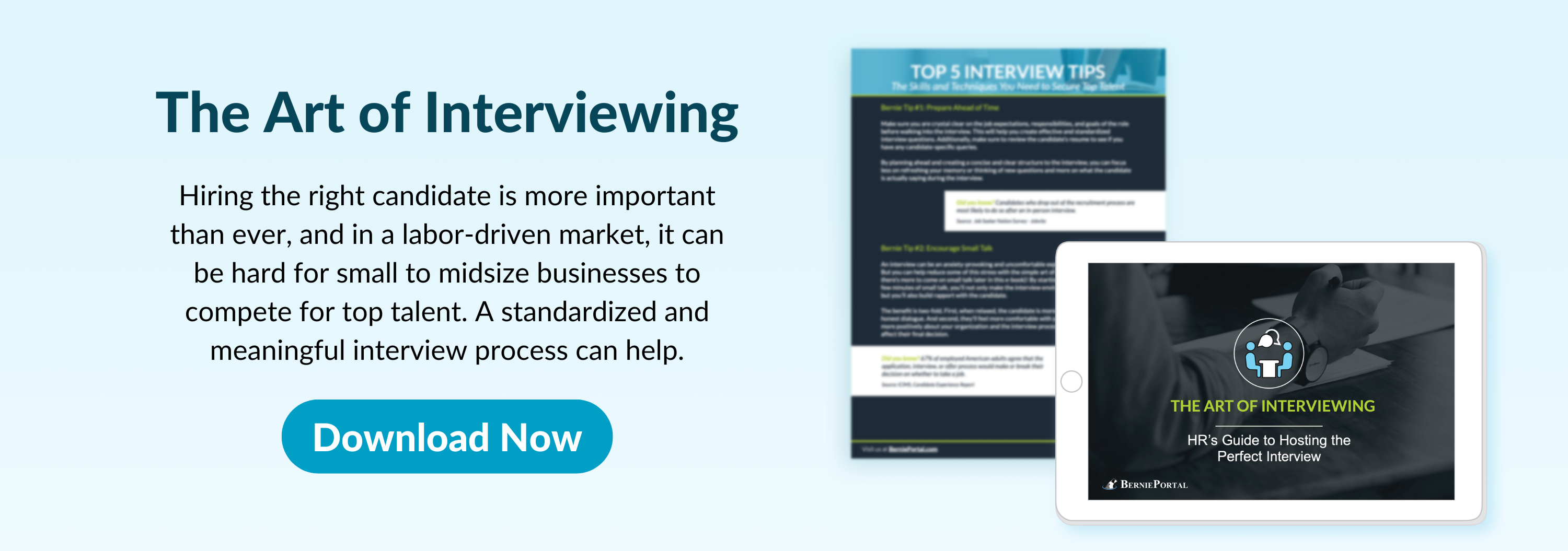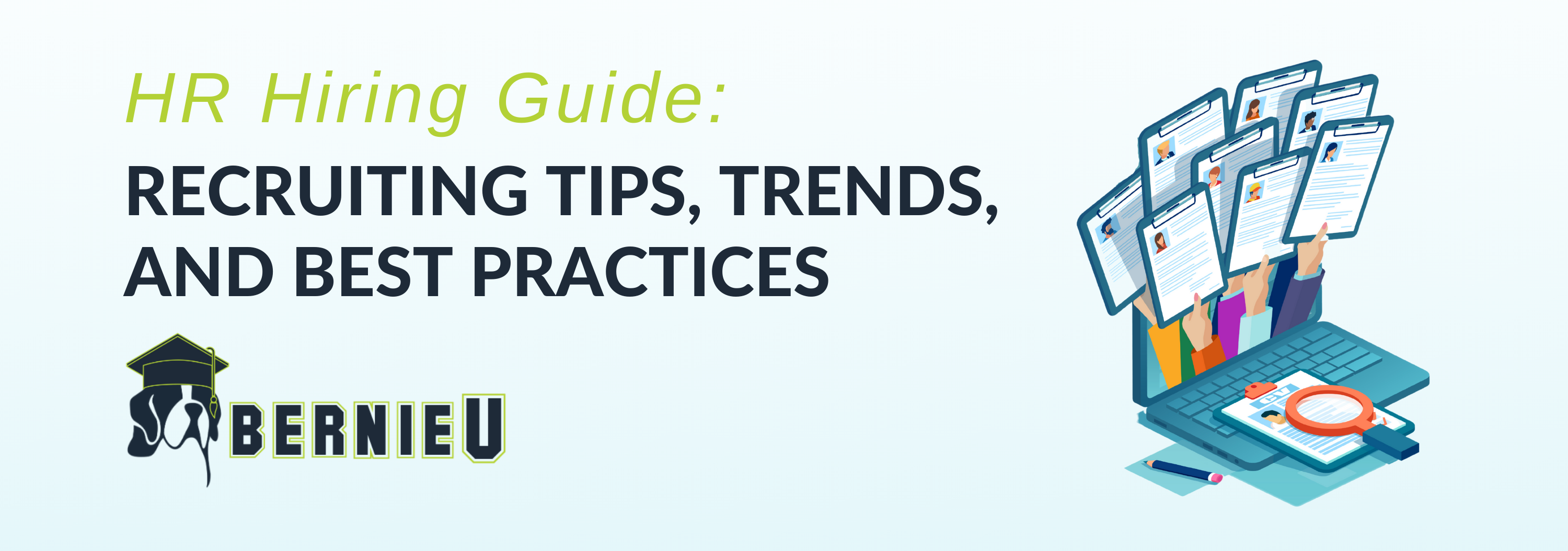
Written by
Aidan Farrish
Aidan is an aPHR-certified writer on the marketing team at BerniePortal. She writes about HR, healthcare, and benefits.
What Do Applicants Want Most?

As an HR pro, or anyone involved in the hiring process, you are likely slightly removed from your job-hunting experiences. You remember the stressors of applying and anticipating rejection or losing out on a position you thought you had in the bag. You may particularly remember the anxiety of waiting for that final answer.
Now, you’re on the other side of things, and it’s your duty to prevent others from experiencing what you did—your attention now can help job hunters manage the same stressors you experienced.
The reality is that the application, interview, and selection of a new employee puts you in a position of power over the hiring process. And candidates know it; they look to you as their source of information. As the source of knowledge and authority in this process, you can influence candidates not just after they apply, but for any future opportunities in their network, as well.
What Do Applicants Want Most?
In a tight labor market, you need every trick in the book to score the best talent over your competition. In your position of power over the hiring process, you can provide what candidates want the most: communication.
Why You Should Communicate Better with Applicants
When someone applies for your open role, you rarely know why they are seeking a new job.
They could be exiting a toxic work environment, reentering the workforce after a leave of absence, or looking for their first position post-grad. They may just be looking for something new to beef up their resume. Regardless of their reasons, they applied for your open role, and you must evaluate their fit and determine a course of action.
When you determine your course of action, you need to be careful to ensure that you’re not becoming part of the problem—the problem many applicants attribute to poor communication.
Roy Maurer, an editor and talent acquisition specialist for SHRM, writes that candidate resentment against noncommunicative recruiting processes is steadily rising. According to a SHRM study, 34% of applicants surveyed didn’t hear back from employers two months after they applied, only 58% got an automatic response, and only a minuscule 7% were informed they didn’t get the job.
Communication is key to building a robust hiring pipeline, yet communication is sorely lacking across the board. When so many organizations are dropping the ball on the most critical aspect of grappling with this tight labor market, you have an excellent opportunity to competitively better your hiring odds now and in the future. So how do you become part of the solution?
How to Communicate Better with Applicants
When you post a position online, through a job board like Indeed or a comprehensive applicant tracking system offered by an HRIS like BerniePortal, you communicate with potential candidates for the very first time. A job description is the first impression you, and your organization, make on interested candidates, so writing a good one is critical to securing applications from the best talent.
Communication 101: Writing the Best Job Description
A transparent, well-structured job description is much more attractive to applicants than a disorganized mess that conceals essential information. The five keys to writing an effective job description are:
- Use clear and concise language
- Highlight the essential job functions
- Include necessary qualifications and experience
- Remain transparent about salary and job expectations
- Emphasize company culture and values
These key strategies will show what your organization needs, how the candidate should provide for those needs in the given role, and how the candidate would fit into your organization. The flow of information is clear and concise, leaving nothing for the candidate to wonder and stress over.
A job description is your first chance to make a good impression on talent in the labor market. BerniePortal offers a job description template that can help you recruit the best talent. But that isn’t the last stop on your journey to bettering your hiring process. Communication also extends past the application stage and into the meat of the interview pipeline.
Communication 102: Keeping Applicants Updated
Like I said earlier, you (as the hiring manager or influencer) control the flow of information during the hiring process. So after weeding out your applicants and selecting who to move forward into your hiring pipeline, consider that you now have the responsibility to inform candidates of their advancement in your hiring process.
People applying for jobs want many things from the hiring process: transparency, speed, feedback…. But what they want most is communication. If you’re wondering what that means and how to do it, luckily, the answer is simple: be honest with them.
If your organization isn’t moving forward with a candidate, let them know. People hate to feel as if their time was wasted or to stressfully await that final phone call. Job offer anxiety can impact how a candidate views your organization. The more honest you are during this time, the better your reputation.
It may seem counterproductive that letting a candidate know they didn’t get the job will help your organization’s reputation. No one likes rejection, but in this case, you would instead earn the former candidate’s respect and gratitude than sour them against your organization by avoiding a tough conversation.
Keep the line of communication open. When you build a relationship with rejected candidates, you gain access to their network of potential candidates for your organization. More importantly, you keep in contact with someone who may not fit your open role right now, but who may be the perfect fit in the future.
You lose nothing by choosing the route of open, honest communication. Your candidates will appreciate that your organization doesn’t leave them hanging during an anxiety-inducing time. If you have a position that attracted a lot of applicants, you can use an ATS offered by an all-in-one HRIS like BerniePortal to inform all applicants that the position has been filled en masse. This saves you the time of individually contacting everyone who missed out on that role.
If you have a smaller pool of applicants, your next consideration should be making time to ensure this key aspect of recruitment follow-up is happening.
Communication 103: Do Recruiters Need Feedback?
You know how important it is to develop your workforce with good feedback, but that applies to you, too. Not every rejected applicant is going to respond to requests for feedback on your interview process, but you can effectively utilize the responses of those who do to further improve.
Lars Schmidt, found of Amplify and author of "LinkedIn Presents: Redefining Work Podcast & Newsletter," shares a key resource that can improve your recruitment process in the long run. Use his candidate's feedback survey to kick-start how you request feedback from those who pass through your recruitment process.
Is HR Too Busy to Focus on Recruitment?
Your day is busy, and alongside checking in on how teams fill open roles, you have many other duties that take precedence over emailing someone to let them know they are moving forward. However, this is a time when you should be involved. So when time is your most finite resource, how can you use it effectively and strategically?
Easy: you outsource the applicant tracking process to your all-in-one HRIS. In a tight labor market, an ATS is an invaluable tool to hone your competitive edge and get the best talent on the market—before someone else does.
The whole purpose of an HRIS, and the ATS it provides, is to streamline the responsibilities of HR to convert time spent on laborious tasks into time spent on making your organization the best place it can be. You do that by staffing your organization with the best people around, so your involvement in the hiring process is vital to your success.
With so much on the line, it’s time to strategize your role to the max. BerniePortal has everything you need to strategize your role and your recruitment process.
BerniePortal’s applicant tracking system contains in-house messaging where you can converse with applicants and grant involved team leaders and members access to their answers. Move applicants along the hiring pipeline with custom hiring stages designed for your organization’s needs. And when you or other hiring influencers are stuck, you can use our ATS to pull together involved employees to review the top candidates and make final decisions.
Your organization is great, but it could be the greatest if you had a way to focus on what matters. BerniePortal can help you make your role as strategic as you want.
Additional Resources
You can stay informed, educated, and up to date with important HR topics using BerniePortal’s comprehensive resources:
- BernieU—free online HR courses, approved for SHRM and HRCI recertification credit
- BerniePortal Blog—a one-stop shop for HR industry news
- HR Glossary—featuring the most common HR terms, acronyms, and compliance
- Resource Library—essential guides covering a comprehensive list of HR topics
- HR Party of One—our popular YouTube series and podcast, covering emerging HR trends and enduring HR topics

Written by
Aidan Farrish
Aidan is an aPHR-certified writer on the marketing team at BerniePortal. She writes about HR, healthcare, and benefits.
Related Posts
The first impression an employer makes is just as important (if not more important) than...
Organizations usually take one of four major approaches when talking about pay.
SHRM states that for HR, overlooking social media today would be like “ignoring e-mail 20...
Recruiting, acquiring, and keeping the right employees for your organization is the best...










Submit a Comment